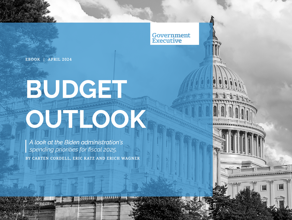Putting People First: Setting the Stage for Productivity in Hybrid Workplaces
Agencies need the right tools and resources to stay engaged, motivated and productive — both for their personnel and for the public who relies on them.
Presented by
Google Cloud

It is critical for in-person, hybrid and remote employees to have easy, unified access to the resources they need to complete projects efficiently and provide constituents with the services they rely on. But navigating complicated, disparate systems can waste time and hinder productivity, both for government staff and for the people they serve.
When agencies adopt tools that allow them to streamline internal communication and easily adapt workflows, they can increase engagement, improve productivity and achieve mission success.
“Even saving just a minute or two on common tasks really adds up; whether it’s a suggested email or text reply, a reminder that I owe a reply to an email, or a calendar suggesting a time for me to meet with a colleague, employees can save a lot of time and mental energy” says Katie Tobin, head of Workspace Innovation for Google’s Global Public Sector team. “This way, employees can focus less on logistics and more on providing government services.
Avoiding Fatigue is Key to Productivity
For many, working remotely can blur the lines between work and personal life. Being at home established a facade of constant availability, leaving employees in a stream of meetings without breaks.
“We ended up getting into this pattern of forcing ourselves and our workmates to feel that it is completely acceptable to just have back to back meetings,” says Jeff Brown, the North America Team Lead for the Google Workspace Public Sector team, who states that employees need technology with built in tools that help put blockers between life and work that make it intuitive and easy to schedule time for their productivity, concentration, and general well-being.
He cites Google Calendar as a solution that provides a human-focused set of features, including the ability to set a work location, establish in-office hours and build in focus time. Tobin adds that the platform’s capability to analyze, suggest and automate scheduling balances work and personal wellness, ultimately increasing productivity.
“Figuring out meetings becomes easier and less stressful because if you are on a break or unavailable, you can set your calendar to auto-decline,” Tobin says. “Which gives the scheduler immediate notice and gets everyone on the same page faster.”
Streamlining Workflows for Simpler Communication
Timesaving communication should extend outside the calendar, as well — especially in agencies, where most projects or tasks require multiple stakeholder approvals, insight from leadership or collaboration with other departments.
To speed up success, agencies can adopt AppSheet, a platform that allows users to automate traditionally manual processes by creating no code, easy to build internal applications.
AppSheet gives agencies the ability to customize their workflows and connect a wide range of data sources, from spreadsheets to Salesforce. Government agencies are using AppSheet to schedule conference room and desk reservations, approve vacation requests, and manage grant applications.
“We can’t afford to be all or nothing in today’s workplace,” says Brown. “To maximize productivity for users, we have to coexist and be interoperable with different solutions agencies have and create in the shadow IT silos.”
Improving the Constituent Experience
As agencies continue to streamline internal operations, they will be able to focus more time and energy optimizing the agency experience. Tobin points to Eagle County, Colorado which has been able to expedite communication with the public by using Google Forms, a free, web-based software that polls citizens then consolidates the information in a digestible way for decision makers.
“The form handles information intake from citizens, which is a great and more efficient way to communicate with the government rather than having to email or call,” she explains. “Then they go through AppSheet to connect things in the back end and send the information to the right department, making communication so much more productive for employees and citizens.”
Agencies looking for ideas and tips to increase productivity can find success stories like this through Public Sector Connect, Google Cloud’s community-led platform that connects government employees across the country.
“It's a free, government-centered, educational place for users to share best practices and ask each other for help,” says Tobin, noting that the platform is great for connecting peer to peer to learn how other agencies are using Workspace and other Google solutions to solve fundamental operational challenges.
“As the definition of productivity changes and expands, understanding of what's possible can be a huge challenge to overcome,” she says. “Knowing how Google Workspace tools can enable employees to save time and remove complexity from everyday workloads will help agencies align with solutions that are right for them, and power mission success.”
Learn more about how Google Cloud capabilities can improve productivity.
This content is made possible by our sponsor. The editorial staff was not involved in its preparation.
NEXT STORY: How Agencies Can Foster Inclusion in the Remote Workforce





